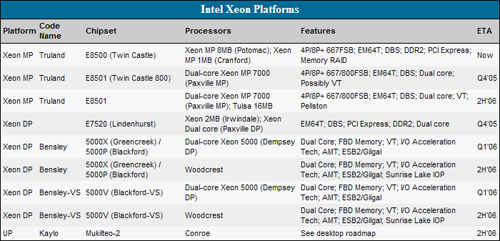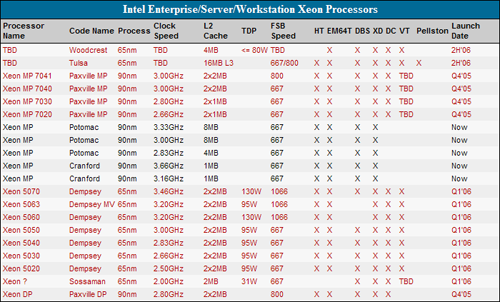Intel Enterprise and Corporate Roadmap - Q3'05 Update
by Jarred Walton on September 12, 2005 12:00 AM EST- Posted in
- CPUs
Server and Workstation Roadmap
Beyond the Stable Image Platform, the main areas of interest for corporate and enterprise customers are going to be the server and workstation parts. Many roadmaps come and go with few changes to these areas. A few new parts might be announced, but generally the business/enterprise roadmaps are far less volatile than the consumer sector. This is one of the rare occasions where we get a large number of new parts showing up all at once, and in some ways it's a reflection of the recent IDF announcements. In other areas, though, we're simply seeing the Xeon equivalents and enhancements of the desktop world. There have been some updates to the Xeon platforms, so we'll look at those before moving onto the processors. |
| Click to enlarge |
Among the conglomeration of acronyms, code names, and features, Intel has announced the names of the next generation chipsets. 5000X, 5000P, and 5000V coincide with the Greencreek, Blackford, and Blackford-VS code names that we had up until now. The chief difference between 5000X (Greencreek) and 5000P (Blackford) is in the configuration of the PCI Express lanes. Greencreek combines two X8 lanes into an X16 slot, while Blackford has three separate X8 connections. It's difficult to think of many uses for the 4000 MBps of bi-directional bandwidth that X16 offers that don't require server functionality, so the chipset breakdown seems to make some sense. 5000V is listed as the "Value DP" chipset, and it comes with some limitations. It only supports one X8 PCIe connection and has a maximum capacity of 16GB of RAM using 8 DIMMs. In contrast, 5000X/P both support up to 64GB of RAM over 16 DIMMs. All of the 5000 series of chipsets also support PCI-X, SATA, I/OAT, and AMT.
Another interesting aspect of the chipsets is the supported bus speeds. Xeon MP will get a bump up to 800FSB with the next chipset, providing for either 667 or 800FSB speeds. Meanwhile, on the Xeon DP chipsets, 800FSB is actually missing. Instead, we have both 667FSB and 1066FSB parts - these are for the upcoming 65nm processors; the current generation 90nm parts will run on current chipsets at 800FSB. The Xeon MP 800FSB is for a few select, high-end parts, with the majority of Xeon MP chips continuing to use 667FSB. Xeon DP is already at 800FSB for most of the parts, so 667FSB is actually a step backwards. Sossaman is the exception, as that chip is the Xeon version of Yonah, but several of the 65nm Dempsey chips will also use 667FSB. Two steps forward, one step back it seems.
Besides the above server platforms, there are also workstation platforms that more or less echo what's listed. Glidewell is the workstation version of Bensley, and Wyloway matches up with Kaylo. There are a few differences, though, like the use of the 975X chipset for Wyloway. No memory type was listed for Truland, but we would assume that it will also be FBD like Bensley and the other 5000 series chipsets. We found the use of the same chipsets for the upcoming NetBurst-based processors as well as the Conroe/Woodcrest parts to be a refreshing change - we won't be forced to upgrade for the new parts, unlike the 915/925 to 945/955 launch. Of course, these are all future chipsets, so no current motherboard or chipset will support the next generation architecture.
That takes care of the platforms, so let's move to the upcoming Xeon processors that will be used in these platforms.
 |
| Click to enlarge |
Many of the entries simply copy the desktop offerings, although the package/socket for the DP and MP systems differs from that of the desktop offerings. We omitted the UP chips, as they are nothing more the Pentium 4 and Pentium D and we've already covered those. We've also left out the majority of the already shipping processors, like the Irwindale and Nocona Xeon DP parts. We did include all of the current Xeon MP parts, mostly because the large cache sizes are impressive. If the 4MB and 8MB Potomac L3 cache sizes aren't big enough, hopefully the 16MB L3 cache of Tulsa will be sufficient! Tulsa takes advantage of the 65nm process shrink to reach its large cache size, while the other Xeon MP parts all make due with 90nm technology. Such large cache sizes make for big - and expensive - chips, needless to say. Tulsa is also the only Xeon chip to get the Pellston technology, which we'll discuss more when we get to Itanium.
Where AMD launched Opteron dual core parts first and followed up with the Athlon 64 X2, Intel has gone the other route and launched Pentium D first, with the Xeon DP/MP parts only now nearing completion. The model numbers of Pentium 4/D/M have spread to the Xeon line as well, with all of the newest parts receiving names in the thousands. 7xxx is for Xeon MP parts and 5xxx is for Xeon DP parts. The 7020 through 7041 will use the older Paxville MP core - the Xeon variant of Pentium D and Smithfield. The 5xxx parts will use the Dempsey core instead, making them Xeon flavors of the Presler core. The Tulsa core is also dual-core, so it will likely get a 7xxx model number as well in the future. There is also one Paxville DP part scheduled for launch, the 2.80GHz chip. Unlike the MP dual core chips, this part doesn't earn the right for a model number. It is also the only 90nm dual core DP part - perhaps 7040 chips that didn't make the cut will be binned as Xeon DP 2.80 chips? We've already talked about the various bus speeds that will be available for the Xeon platform, and you can find the specifics in the table. VT is also targeted to launch with the Xeon MP 7xxx series, although Intel may choose to cut that feature between now and launch, so it is still "To Be Determined" (TBD).
Other than the NetBurst chips, we have a few other parts coming out. Sossaman is the server variant of Yonah. While Intel didn't list TDP for all of the parts - and TDP is itself a misleading number - we do get the 31W TDP of Sossaman at 2.0GHz. That's about one third of the TDP of the Xeon chips, and Intel's talk about performance per Watt is realized in such designs. The other part that shows up for the first time on the corporate roadmaps is Woodcrest. Woodcrest is the server/workstation version of Conroe - at least, one of the versions. While we know that Conroe will have both 2MB and 4MB versions, for now the server edition will be 4MB of cache only. That makes sense, as servers and workstations run application loads that benefit more from additional cache than desktop applications. Other than the amount of cache and the features that will be enabled on the initial Woodcrest parts, we don't have any specific core speeds. Even the "less than 80W TDP" is pretty vague - we'd imagine Woodcrest and Conroe will be targeting more like 50W TDP, judging by Yonah, but that's more of a guess than anything. Sossaman will also get the Xeon monicer, as far as we can tell, while Woodcrest is still TBD.










21 Comments
View All Comments
yorthen - Monday, September 12, 2005 - link
Yes, I've heard a lot about VT and AMT but never found any good explanation of how it actually works. I understand that using VT will enable Xen to run unmodified OSes, but what is it that VT does that a normal processor can not, and how does it compare to AMD's virtualisation-technology?And what about AMT, which is supposed to provide OS-independent management capabilities, what kind of operations does it allow?